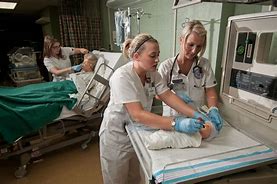A future without enough nurses is unacceptable.
There is some good news.
Clinical nurses make a lot more money now than they used to. COVID fixed that. The travel nurse bubble is burst, but the pay raises for staff nurses appear to be sticking.
The raises for nurses across the field were very large, whether they stayed where they were or were recruited elsewhere. There was a lot of churn, but nurses deserve the extra money. We know where that money will come from. Price increases for medical care and insurance.
But COVID also caused so many nurses to retire or otherwise leave the field that it both exacerbated and exposed shortages that predated the pandemic.
The supply of new nurses is bottlenecked at the nursing schools. But the reason flips the teacher supply problem on its head.
Unlike the shortage of teachers, which begins with a severe shortage of people who want the job, the shortage of nurses is traceable in Virginia and nationally to a lack of nursing school faculty to teach them.
It is of course a money issue at most of Virginia’s 81 nursing programs, and one we have no option but to address.
Nursing school staffing is not a new problem.
In 2019-20, before the COVID-associated spike in field nurse salaries, 26% of qualified applicants were turned away from Virginia’s nursing schools. Trends were similar across the country.
During COVID, salaries for nurses in the field quickly and massively outstripped those of nursing school faculty, making it very hard for those schools to retain nurses on staff, much less to expand those faculties to meet demand.
Post-COVID, the raises in the field have proven sticky, making it much harder to retain and recruit faculty. Most of Virginia’s nursing programs don’t have the resources to raise faculty salaries to the levels required to be competitive.
Cardinal News reported at length in February on the problem.
The short version:
- The nursing schools cannot expand to meet increased demand from both the input and output ends. They not only have vacant faculty positions, but the average age of existing faculty is quickly rising.
- The faculty pay increases necessary to correct the imbalance are estimated to be about $30,000 per year per instructional position.
- Virginia needs to find ways to fund both the raises for existing positions and the new ones.
- In addition, hospitals and other nurse employers configured to teach will need to expand their ability to accept nursing student placements for internships.
- The GA is being asked to fund a study.
Richmond, thick with lobbyists for both the employers of nurses and the nursing schools, should be able to come up with:
- the total number of nursing school instructors needed;
- the raises needed to keep the existing positions filled;
- the number and costs of nursing internships;
- and the amount of new money — salaries and benefits — for some definable number of new positions.
The hard part is who pays.
Who pays? Obvious candidates to contribute to the financial solution are:
- The employers of nurses. The state is among those employers. Lobbyists for private employers — Virginia hospitals, ASCs, nursing homes, home healthcare providers, physician groups, etc. — will want the state to pay.
- The state as government. Negotiators for the state will want its wealthy, COPN-protected healthcare monopolies to pick up most of the tab. That is a more than reasonable position, as they can afford it and they will be beneficiaries of the increased supply. The state will look to Medicaid first if government money is to be used. Medicaid will likely be tapped to pay for additional nurse internships;
- Nursing school tuition. Many will also want to consider nursing school tuition increases to help fund the faculties. On the surface that makes some sense. But economics 101 will tell us that price increases will shrink demand until there is market equilibrium. And we can’t afford to shed qualified applicants. Scholarships can be funded by employers and the state to make up the difference in affordability for students that need help. That brings us back to the first two contributors.
So, we have the outlines of a deal. There will be sharp elbows in the negotiations between employers and the state, but one can be had.
Virginians of all stripes will want the deal to be cut sooner rather than later.


Leave a Reply
You must be logged in to post a comment.